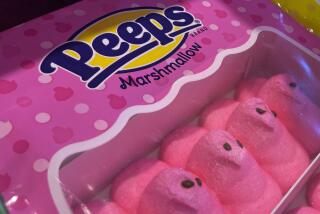FDA Bans Some Uses of Red No. 3 Additive
WASHINGTON â The Food and Drug Administration today banned some uses of the color additive Red No. 3, saying studies have shown that in very high doses it causes cancer in laboratory animals.
âTodayâs action prevents further use of this color additive in about one-fifth of its uses--in cosmetics such as lipsticks, in externally applied drugs and as a pigment form called âlakesâ in food, drugs and cosmetics,â the FDA said in a news release.
It said that because studies showed the risk from using Red No. 3 is considered small, consumers may continue using existing supplies of products that contain the color additive.
The FDA also said it is in the process of extending the ban to cover those uses for which Red No. 3 still is approved.
Products for which use is banned include shampoos, lipsticks, powders, skin-care products, baking mixes, wax coatings for cheese, chewing gum, confections and frostings, gelatins, puddings, fillings, hard candy, herbs, spices, seasonings, processed fruits and juices, drug tablet formulations and liquid drug preparations.
Catherine J. Bailey, consumer safety officer at FDA, said products for which some use is still approved include soft candy, breakfast cereals, hard candy, juices, meat products, chewing gum, maraschino cherries, icings, cake decorations, cakes, plant protein products, canned puddings and sweet rolls.
All uses of Red No. 3 in cosmetics are being banned.
The FDA has been studying the additive for 30 years. Under pressure from industry groups and members of Congress, the agency has been reluctant to impose a ban.
âThe actual risk posed by Red No. 3 is extremely small. However, federal law in this area is clear,â said Dr. Louis W. Sullivan, secretary of health and human services.
âThere have been laboratory studies which showed that very high doses of Red No. 3, administered directly in the diet, caused cancer in rats,â he said. âIn these circumstances, small as the risk is, we have no choice under the law but to end the provisional listing of this product,â he said.
Sullivan said the FDAâs action illustrates the rigidity of the law and said Congress should consider updating the statutes âto reflect advances in the methods of scientific assessment that were not available when the law was originally passed in 1960.â
The risk of getting cancer from Red No. 3 is no larger than 1 in 100,000 over a lifetime of consumption, the FDA said. In comparison, the risk from natural disasters is about 70 in 100,000 and from disasters such as railroad accidents and air crashes, the risk is about 6 in 100,000, the agency said.
The red dye has been on a âprovisional listâ since 1960, when Congress called for a ban on foods that cause cancer in laboratory animals. At the time, about 200 color additives were put on the provisional list, allowing them to stay on the market for an additional two years pending further study.
More to Read
Sign up for Essential California
The most important California stories and recommendations in your inbox every morning.
You may occasionally receive promotional content from the Los Angeles Times.









